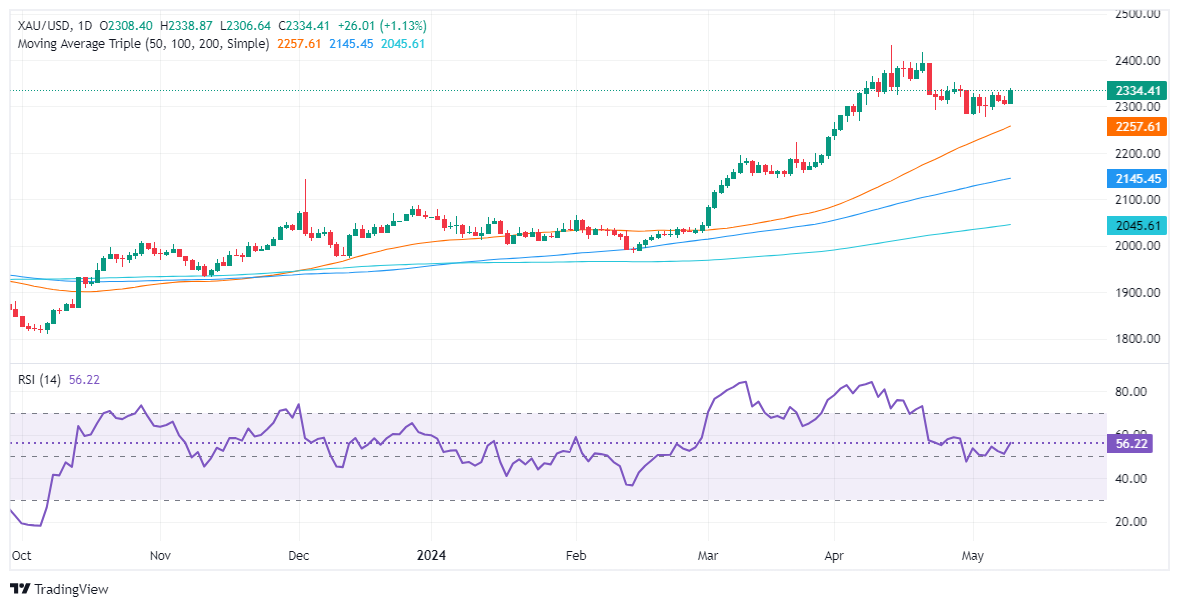- Gold bounces above $2,330, boosted by falling US Treasury yields and weaker Dollar.
- Jobless claims are rising, putting pressure on the Fed to meet its dual-term goals and possibly cut rates sooner.
- Fed officials reflect conflicting views on the health of the economy and the direction of monetary policy.
The price of Gold resumed its upward trend on Thursday and rose more than 1% as falling US Treasury yields sapped appetite for the Dollar. United States (US) labor market data was weaker, raising the chances of a rate cut by the Federal Reserve (Fed) despite facing inflationary pressure.
XAU/USD is trading above the $2,330 area after bouncing off daily lows of $2,306. On Thursday, the US Bureau of Labor Statistics (BLS) revealed that the number of Americans applying for unemployment benefits rose above estimates and the previous report, indicating that the economy is losing steam. This could influence the Fed's future monetary policy decisions, after recognizing that it is focused on its dual mandate: full employment and inflation.
Meanwhile, a slew of Fed officials had crossed the news wires during the week. On Monday, Richmond Fed President Thomas Barkin commented that the recent data has been “disappointing,” adding that the job is not done. For his part, New York Fed President John Williams noted that consumers continue to spend, adding that the economy remains in good health despite growing more slowly.
On Tuesday, Neel Kashkari of the Minneapolis Fed said it is most likely to keep interest rates where they are in 2024, adding that inflation growth has stalled. Yesterday it was the turn of the president of the Boston Fed, Susan Collins. She stated that she is optimistic about the possibility of bringing inflation to the 2% target, adding that current monetary policy is well positioned and “moderately restrictive.”
Daily Market Moves Summary: Gold Strengthens as US Data Raises Fed Rate Cut Hopes
- Gold prices fell amid declining US Treasury yields and the strength of the US Dollar. US 10-year Treasury yields are yielding 4.457%, four basis points lower than at the open. The US Dollar Index (DXY), which tracks the USD against six other currencies, fell 0.25% to 105.25.
- The U.S. Department of Labor reported that initial jobless claims for the week ending May 4 totaled 231,000, exceeding estimates of 210,000 and showing an increase from the previous week's figure of 209,000. . The spike in jobless claims suggests a cooling in the US labor market.
- Weaker-than-expected labor market numbers, as shown by last month's U.S. jobs report and jobless claims data, could put pressure on the Fed. Officials acknowledged that the risks to reaching the dual mandate of The Fed's efforts to encourage maximum employment and price stability have become more balanced in the last year.
- Gold has advanced more than 12% so far in 2024, thanks to expectations that major central banks will begin to reduce rates. Renewed fears of a resumption of the Middle East conflict between Israel and Hamas may lead to a rise in XAU/USD prices.
- According to Reuters, the People's Bank of China (PBoC) continued to accumulate gold for the 18th consecutive month, adding 60,000 troy ounces to its reserves amid higher prices.
- Following the data release, the Fed's rate cut odds increased from around 33 basis points (bps) to 38 bps of rate cuts by the end of 2024.
Technical analysis: The price of Gold resumes its upward trend and exceeds $2,330

Gold maintains its bullish bias, despite having retreated 6% from its all-time high of $2,431, reached on April 12. Momentum shows that buyers are gaining strength, which is seen in the RSI, which has been turning bullish since early May.
That said, XAU/USD buyers need to break through the April 26 high, the last cycle high at $2,352. Once surpassed, the figure of $2,400 would be exposed. Breaking the latter would accelerate the rally towards the April 19 high of $2,417, before challenging the all-time high of $2,431.
On the contrary, if Gold falls below the $2,300 mark, further losses would occur. The next support would be the 50-day SMA at $2,249.
Frequently asked questions about Gold
Why invest in Gold?
Gold has played a fundamental role in human history, as it has been widely used as a store of value and medium of exchange. Today, apart from its brilliance and use for jewelry, the precious metal is considered a safe-haven asset, meaning it is considered a good investment in turbulent times. Gold is also considered a hedge against inflation and currency depreciation, since it does not depend on any specific issuer or government.
Who buys more Gold?
Central banks are the largest holders of Gold. In their aim to support their currencies in turbulent times, central banks tend to diversify their reserves and purchase Gold to improve the perception of strength of the economy and currency. High Gold reserves can be a source of confidence for the solvency of a country. Central banks added 1,136 tons of gold worth about $70 billion to their reserves in 2022, according to data from the World Gold Council. This is the largest annual purchase since records exist. Central banks in emerging economies such as China, India and Türkiye are rapidly increasing their gold reserves.
What correlation does Gold have with other assets?
Gold has an inverse correlation with the US Dollar and US Treasuries, which are the main reserve and safe haven assets. When the Dollar depreciates, the price of Gold tends to rise, allowing investors and central banks to diversify their assets in turbulent times. Gold is also inversely correlated with risk assets. A rally in the stock market tends to weaken the price of Gold, while sell-offs in riskier markets tend to favor the precious metal.
What does the price of Gold depend on?
The price of Gold can move due to a wide range of factors. Geopolitical instability or fear of a deep recession can cause the price of Gold to rise rapidly due to its status as a safe haven asset. As a non-yielding asset, the price of Gold tends to rise when interest rates fall, while rising money prices tend to weigh down the yellow metal. Still, most of the moves depend on how the US Dollar (USD) performs, as the asset is traded in dollars (XAU/USD). A strong Dollar tends to keep the price of Gold in check, while a weaker Dollar is likely to push up Gold prices.
Source: Fx Street
I am Joshua Winder, a senior-level journalist and editor at World Stock Market. I specialize in covering news related to the stock market and economic trends. With more than 8 years of experience in this field, I have become an expert in financial reporting.







